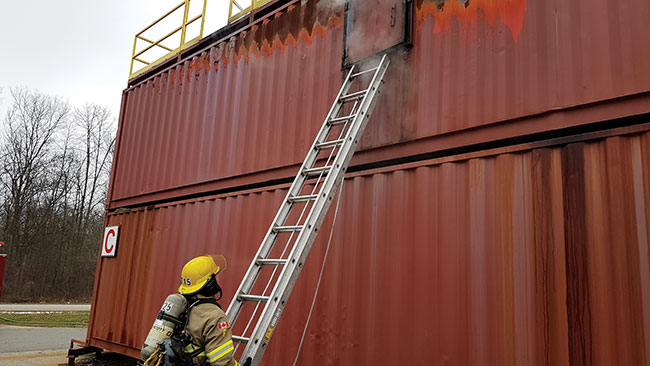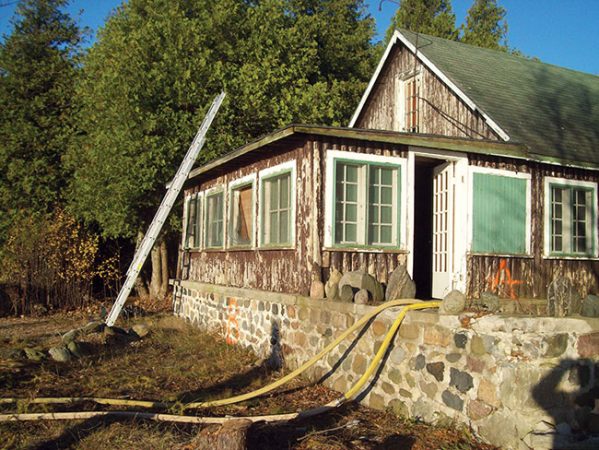
Features
Back to Basics: Ladder Dating: The summary
June 7, 2021
By
Mark van
 Photo 1: The ground ladder has been proven to be a valuable tool on the fire ground with its quickness for deployment, effectiveness for rescues (both civilian and firefighter), and gaining access. Photos by Mark van der Feyst
Photo 1: The ground ladder has been proven to be a valuable tool on the fire ground with its quickness for deployment, effectiveness for rescues (both civilian and firefighter), and gaining access. Photos by Mark van der Feyst
For the last 11 issues, we have focused our attention on ground ladders with the intent of getting to know the ground ladder all the more, hence why the title of the series is Ladder Dating. In my introduction to this topic, I used the analogy of dating a person before marriage as being akin to the firefighter’s role in getting to know the ground ladder.
The ground ladder has proven to be a valuable tool on the fire ground with its quickness for deployment, effectiveness for rescues (both civilian and firefighter), and for gaining access. We can see in the past how the ground ladder has performed well for rescues. On Sept. 23, 2019, seven rescues were made during a three-alarm fire at a nursing home in Lehigh County, Pa.
As we come to the end of our series, I want to recap all that we have looked at in the last 11 issues, sort of a “Coles Notes” version of ladder dating. The main intent of this series is to arm the training firefighter or officer with the proper information and skill set to instruct their department’s personnel or fellow crew members on using the ground ladder.
The angle of the ground ladder was the first look at the series with a focus on not needing the exact 75 degrees for the ladder when it is raised against a building. Having a less intrusive angle, such as 65, 60 or 55 degrees, will still accomplish the same result of gaining access or performing a rescue, except without the time taken to ensure that we have the perfect climbing angle. The less intrusive angle will assist with firefighter survival during ladder bailouts, should it be required or performed. The ladder is tested to withstand the weight of a firefighter and civilian or two firefighters on a horizontal plane. Having the ladder against the building at a less intrusive angle will work.
The placement of the ladder tip was explored with the message of always laddering the building with the tip of the ladder at, or below, the windowsill. The best position that a ground ladder should be set to is with the ladder tip at the bottom of the windowsill – all the time, every time. There are two main reasons for laddering a building: access and egress. The access portion involves the rescue of the occupants from inside the building, venting a window, and spraying water into the building. The egress portion involves firefighters needing to get out of the building quickly. Having the ladder tip at the windowsill allows all the functions of access and egress to be performed.
Ladder extension limitations involves knowing ladder math, common ladder lengths and what they can reach. A 24-foot ladder will reach the third-story window, while a 35-foot ladder will reach the fourth-story window. A 14-foot roof ladder is the same length as a 24-foot ladder bedded. A two-section 28-foot extension ladder is 16-feet bedded, while a two-section 35-foot extension ladder is 18-feet bedded.
We also looked at the halyard of the ground ladder and the role it plays with the ladder being tied off. The main reason behind not tying off the halyard after extending it is for immediate rescue purposes. If the ladder is being extended for other reasons, such as ventilation or gaining access to an upper portion of the building, and time is available to do this, then certainly tie it off, if required. But, the ground ladder can sit there with the halyard untied and it will still work. For multiple rescues at different points of the building with the same ground ladder, having the halyard untied will allow for quick extension, making the rescue, then lowering to move to the next spot on the building.
Being familiar with the weight and feel of the ground ladder is how a firefighter develops muscle memory. The ladder will weigh differently based on the construction type of the ladder, be it solid beam or truss. The weight and feel of a ground ladder can be rooted into the firefighter’s being so that whenever they grab that ladder, it will not be a surprise to them as to how much it weighs or how it feels when trying to raise it into position.

Photo 2: Having a good number of rungs above the roof line will also assist with getting off and getting back on easily.
Heeling the ground ladder is best from the front as opposed to from the rear of the ladder. At the front, the firefighter can observe more of what is going on, can assist the firefighter on the ladder, and will be out of the way should anything fall.
One firefighter can be effective using the high shoulder carry and ladder throw. The firefighter can easily throw the ladder up against the building from this position and also bring it back down in the same fashion. Having the ladder marked in the middle is one key aspect, as well as becoming familiar with the weight and feel of the ladder.
Working on the ladder can be done in one of three ways: heel-toe method, the knee method and the tool method. These three options alleviate the need to use the dreaded leg lock when working on the ladder. Each of the three options allows the firefighter to be secured against the ladder while being able to get off the ladder easily at the same time.
Whenever getting on or off the ground ladder, the firefighter always wants to maintain positive control. This involves using both hands and being situationally aware. Having a good number of rungs above the roof line will also assist with getting off and getting back on easily.
The focus of the series was to explore what one firefighter can do on the fire ground with respect to ground ladders, but there is also a time when two firefighters will be needed to carry, raise and work on the ground ladder. Carrying a 35-foot three-section ladder or carrying two ground ladders at the same time is where two sets of hands will be needed and used efficiently.
I hope that this series assists you in going back to the ground ladder as a viable tool, not just a tool on the truck. As mentioned a few times in our series, practice with the ground ladder will make the firefighter more effective and efficient.
Mark van der Feyst has been in the fire service since 1999 and is currently a firefighter with the FGFD. He is an international instructor teaching in Canada, the United States, FDIC and India. He is a local level suppression instructor for the Pennsylvania State Fire Academy and the lead author of Fire Engineering’s Residential Fire Rescue book and other DVDs. He can be contacted at Mark@FireStarTraining.com.
Print this page